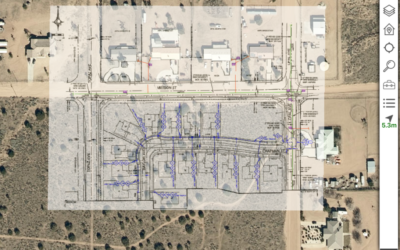Improve decision making, lower costs, and reduce risk using a map-based portal that integrates systems and data.
A data dilemma
Around the world, organizations must deliver critical capital projects that can directly impact the economic development and well-being of communities. Continued population growth, increased urbanization, climate change, and the need for more sustainable cities have dramatically impacted capital project construction. These vital infrastructure projects include highways, roads, airports, ports, rail systems, and more. They involve multiple stakeholders and project teams, often in the public and private sectors, and can stretch across large geographic areas.
Yet achieving business objectives and financial success is difficult. McKinsey reports that 98% of megaprojects face cost and schedule overruns or delays. This occurs for many reasons. Capital improvement projects involve major complexities and risks. These ultra-competitive projects operate at low margins. This means companies must manage costs effectively, particularly avoiding duplications or errors that result in rework.
And at the root of these issues lies a data dilemma. Isolated information, managed in disparate databases, leads to poor decision making. This results in expensive project changes and budget overruns, increased executive scrutiny, and a disenfranchised public.
Further, delivering large projects involves multiple disciplines. Experts in their fields, often from different organizations, frequently come together quickly to form teams. They focus on their area, resulting in functional, stove-piped thinking and associated applications and data. Terabytes of data are created and managed in separate systems and are only accessible through specialist software used by trained professionals. As a result, the comprehensive view of the project is missed, with valuable information remaining hidden in silos, resulting in poor decision making and costly reworks.
Breaking down data silos through a centralized map
Enterprise geographic information system (GIS) technology acts as a strategic enabler for resolving the data dilemma. But GIS technology alone is not enough. You need proper technical understanding of data and project systems, including scheduling, cost management, CAD, document management, surveying, and more.
With an enterprise GIS approach and cross-project system knowledge, you can connect systems and integrate information. You can map assets, lands, and additional object locations and attach relevant data from other systems as attributes. This data is accessed through a user-friendly, web-based map portal to provide a holistic view of project data based on location.
Mapping data to land and infrastructure assets allows people to use location to access related information such as designs, surveys, land ownership, work schedules, etc. They can also find spatial relationships between assets, parcels, rights-of-way, streets, utilities, people, equipment, supplies, scheduled work, and more. Senior leaders, front-line staff, and other stakeholders no longer make decisions using limited information contained in disparate databases.
Moreover, they gain a different perspective—using a spatial context—to discover unknown factors that could force extensive rework. For example, you gain visibility into work status, resource conflicts, and supply demands across the project using an intuitive map interface. You can analyze spatial relationships to avoid scheduling conflicts and rework. Ultimately, using location analytics leads to better designs, plans, and estimates, as well as reduced rework.
Improve project efficiency with accessible data
In a large capital project with terabytes of data in different formats and different systems, the key to effective decision making involves providing stakeholders with easy access to relevant data. An integrated enterprise GIS approach meets this need by supplying project data through web browsers without installing specialist GIS software. This innovative approach allows people to retrieve datasets previously limited to specialists. For example:
Point cloud data, Lidar, and 360 imagery are often only available to surveyors who collected the data or engineers with highly specialized software for analysis and design. All can now use these through open source software without leaving the web-based map portal.
3D CAD models are viewable using web maps, which previously were often only available to designers and modellers using expensive CAD software. Senior leadership can understand how the built asset will look within the area’s geographic context. Engineers and project managers can review designs in 3D before meeting with the designer or other project personnel. Stakeholders, including the public, can view design options during planning phases or before work begins in a simple, intuitive interface.
Georeferenced videos are available by selecting a location on the map. This reduces the time it takes to find the appropriate video footage, whilst reducing the risk of missing features in a specific area of interest. Engineers can perform desktop studies using this data instead of or prior to a site visit. They can assess health and safety risks and ensure the appropriate resources are put in place prior to the visit, ultimately reducing the number of site visits.
Web-based map portals allow role-based security that gives an administrator control over restrictive data. Moreover, organizations can establish relevant datasets for specific roles or processes to enable efficient access to relevant data. You can automatically present the most pertinent information rather than requiring users to search through potentially hundreds of datasets. And with fully searchable metadata, you enable people to find additional datasets.
Enhanced decision support for everyone
A web-based map portal provides a common and coordinated project view that increases understanding and collaboration across teams and roles while reducing risk and costs. Through visualisation, spatial analysis, and comparison of possible alternatives, project staff and stakeholders make decisions based on a more holistic project picture. For example:
Scheduling: Visualise the schedule spatially with a time-slider to understand the project’s status and the next steps in the project build without diving into multiple Gantt charts, spreadsheets, or other applications. Analyze structures to ensure logical links and constraints and the correct sequence of work.
Resourcing: Understand where resources currently reside and when and where they will be needed through the life of the project. Effectively plan for accommodation, accessibility to lavatories, escape routes, medical and emergency services, and more.
Communications: Engage the right people in the right place at the right time by having a clear and accurate view of where and when work will occur. Understand current and future work locations to proactively determine where to focus efforts based on stakeholders and public feedback.
Asset inspections: Access asset information, including historical information about previous inspections, defects, photos, and videos. View geospatial features near an asset, such as access roads, health and safety hazards, and landowner information.
Engineering: Quickly perform asset analysis before going to a site using various geospatial datasets. Point and click to information rather than looking through old files, documents, and paper maps, which are often outdated and usable.
Environmental works: Leverage one-stop-shop access to ecological, landscape, heritage, and related survey data that saves time in compiling reports and recommendations. Meet regulatory compliance to ensure sustainable development practices and patterns.
Consents and estates processes: Streamline and simplify landowner/occupier information retrieval using intuitive map interfaces. Integrate public ownership data from different sources to speed up the Notice of Entry documentation process.
Why Locana for your project?
For more than 30 years, organizations have relied on Locana to provide their in-depth enterprise GIS needs for major construction projects. We also offer project controls, CAD, document management, and other systems integrations.
We will work with you to design, implement, configure, and integrate GIS with your capital project systems quickly and efficiently. We will help you deploy modern software like Esri ArcGIS Enterprise and Oracle Primavera, combined with available open source technologies that provide low-cost options.
Locana maintains an expert team with an international focus, specializing in the full spectrum of GIS and project controls services, from systems strategy to design, build, configuration, integration, adoption, and support. Our staff of industry-leading strategic consultants, project managers, GIS, and project controls experts, and open-source technologists will deliver cutting-edge capabilities combined with proven best practices.
We provide in-depth project management and engineering design capabilities that augment your organizational knowledge and skills. Our deep understanding of data and systems, including scheduling, cost management, CAD, document management, surveying, and more, allow us to build an enterprise GIS system with web-based map portals that supply a complete project view based on location.
The result? Your organization can make well-informed decisions based on available project data. You no longer have hidden siloed data. You gain operational efficiencies, streamlined workflows, reduced rework, lowered risk, simplified resource management, optimized decisions and profitable projects delivered to plan.
***
To find out more about how you can get a holistic view of your project, contact us today or visit our services page.


